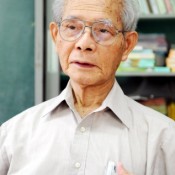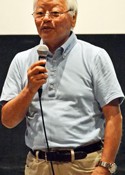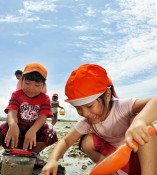
June 25, 2014 Hideaki Yoneda correspondent of Ryukyu Shimpo
On June 24, a seal originating from the North Sea was confirmed to be swimming in the sea near Tokashiki Island. At 8:30 a.m. on the same day, Kazuhiro Tamaki and Hayato Nakamura, members of the Tokashiki Fishery Association, found a seal in a puddle of water between rocks in the southernmost part of the island during their routine patrol to monitor suku or rabbit fishes. At first, they could not believe the scene – a seal was swimming before them. They had never seen such an animal in Okinawa before.
The animal is about one meter long with black patches on its gray back. When the fishermen got close to the seal to feed it saury and krill, it was swimming energetically and ate the food. A few local residents and tourists who heard the news came to see the seal. They could not take their eyes off it.
According to the Okinawa Churaumi Aquarium in Motobu, there is no record of a seal ever being sighted in Okinawa.
(English translation by T&CT, Hitomi Shinzato)
Go to Japanese

The experiences of Shigeaki Kinjo – as told to students at Okinawa Christian University
“It felt like a living hell, it was a nightmare,” says 85 year old Shigeaki Kinjo of his wartime experiences on Tokashiki island, Okinawa. As the 69th anniversary of the end of the Battle of Okinawa approaches, Kinjo is still haunted by what he did as a youngster, when his island was transformed into a grueling battlefield.
The only ground battle of World War II fought on Japanese soil, the Battle of Okinawa raged for almost three months. Over 200 000 people died, including both Japanese and American soldiers but overwhelmingly the victims were Okinawan civilians.
One of the most gruesome tragedies of that battle happened in March 1945 on the Kerama islands – about 30 km off the coast of Naha. On the 26th, some 300 people died in a group suicide on Zamami island. The following day, another 300 perished in similar fashion on neighboring Tokashiki island.
16 year old Kinjo and his family were among those who were gathered together by the Japanese army on Tokashiki Island on March 27th. They had been ordered to assemble in the village of Nishiyama Previously, Kinjo’s life had been a happy one but the war turned people into killers, and it would turn him into a killer too.
Grenades were handed out to those gathered in Nishiyama and the village mayor said Banzai (Long live the Emperor) three times. He says, this was interpreted to mean something like, “you should die.” In those days people had been taught in school that suicide “is much better than being killed by the American army.” They instinctively believed that, “Many Japanese soldiers have died for our country so we should die with them. We should kill ourselves before the Americans kill us.”
So the people prepared to commit suicide using the grenades. However, many of the grenades they’d been given were faulty and failed to detonate. So only a few were killed by the explosives. Those who survived immediately turned on their own families, using knives, sickles or stones to kill them. One man stabbed his wife and children with a broken branch. The air was punctuated with the sound of screaming and groaning. It was, he says, like a scene from the inferno.
Kinjo too, along with his older brother, attacked his mother, younger brother and sister with stones. He says, “I don’t remember the moment I and my brother killed them. I was of unsound mind.” More than half of the population of Tokashiki island died that day.
After they’d killed their loved ones, Kinjo and his brother made up their minds to take their own lives. As they were planning to do so, a boy of about the same age came out of nowhere and suggested they attack the US soldiers instead. Believing they would be killed in the process, he reasoned that at least they wouldn’t have to kill themselves.
However, fate intervened and before Kinjo had a chance to encounter any Americans he came across some Japanese troops. He was shocked to see that they were still alive. He thought the Japanese soldiers would also have killed themselves for their Emperor. He recognized at once the double standard – one rule for the civilians and another for the troops – and was left with a strong sense of betrayal. There and then, he changed his mind and decided against killing himself. Much later, after the war, he realized that mass suicides like those in the Keramas had only happened in places where the Japanese army was present.
Ultimately Kinjo was caught by the US soldiers and taken prisoner. He wasn’t harmed or mistreated by the Americans who distinguished between those who were “Okinawan” and those who were “Japanese.”
At the end of the war Kinjo was racked with guilt. He bitterly regretted that he had killed his family but couldn’t manage to take his own life. Then a chance encounter with a Christian, a Mr Tanahara, led to him to discover the bible. He came across words like, “eternal life” and “forgiveness” and became a Christian himself, coming to believe in the preciousness of human life. Kinjo later help establish Okinawa Christian Junior College.
It was during a recent visit back to this same College, where we are now students, that he told us about these awful events. He says he continues to talk about his experiences, even in old age, in an effort to prevent further bloodshed. “I will never forget what I saw and what I did in the war and so I tell my horrible story.” He adds that the Japanese government also has a responsibility to face up to what the country did more than half a century ago. And in the future, he says, they should make a more concerted effort to get along, not only with America, but also with China and Japan’s other neighbors.
(This contributed article is written by the students of the Investigative Reporting Class, Okinawa Christian University and edited by Michael Bradley)
June 26, 2014 Ryukyu Shimpo
On June 25, Nago City Council adopted a written opinion opposing the expansion of the restricted military area into local fishing watersnear the planned relocation site for the U.S. Marine Corps Air Station Futenma in Henko, Nago. The city council also resolved to oppose Prime Minister Shinzo Abe’s bid to reinterpret the Constitution to enable Japan to engage in collective self-defense. These resolutions were passed by a majority vote.
The Governments of Japan and the United States have agreed to redraw the boundaries of the area restricted for exclusive use by U.S. Forces in the waters off Camp Schwab. They also agreed to expand the area where fishing will be prohibited based on the Restriction on Operation of Fishing Vessels Act. The city council criticized the agreement, saying that the governments have a political intention to force the landfill through, despite the objection of residents. They asked the governments to cancel the expansion of the restricted area to protect the lives and property of citizens.
Referring to the newly restored right of collective self- defense, the city council pointed out that Okinawan people, who bear an excessive U.S. military base burden, are concerned that they will be involved in wars fought by other countries. They criticized the Abe administration, saying that one cabinet’s political judgment has easily changed the interpretation of the Constitution without a national debate.
These resolutions have passed with 16 in favor, 9 opposed and 1 absent.
(English translation by T&CT)
Go to Japanese

June 22, 2014 Ryukyu Shimpo
On June 13, Chatan Junior High School held a peace education class for third-grade students. Special-guest lecturer Eiko Ginoza from the Half Century Miyamori, a peace organization, gave a speech on the theme of “Learning about Peace.” Seven students recited Article 9 of the Constitution of Japan in the original, in English and in Uchinaguchi.
During the class, students watched a war film. Ginoza spoke about war survivors. She told students, “The Japanese government is preparing to change the Constitution. If a war begins, your generation will be sent to the battlefield.”
Students learned the importance of the Constitution. Asuka Nakasone, one of the students who read Article 9 of the Constitution said, “Reading Article 9 in English gave me an opportunity to think about the Constitution, war, and peace.”
(English translation by T&CT and Megumi Chibana)
Go to Japanese

June 26, 2014 Ryukyu Shimpo
A documentary movie about the life of Okinawan war photographer Bunyo Ishikawa was screened at Sakurazaka Theater in Naha on June 25. Ishikawa delivered an opening speech.
He said, “The movie features my experience in the Vietnam War which was deeply related to Okinawa, and the U.S. military base issues in Okinawa, from the view point of the main Island of Japan.”
In the movie, 76-year-old Ishikawa visits Vietnam and Okinawa, and ruminates about the past. It tells the stories of Okinawan people who are still suffering from problems caused by the bases.
Ishikawa covered the Vietnam War as a photojournalist from 1964.
He said, “As an Okinawan who lives in the main Island of Japan, I would like to tell the story of Okinawa to the Japanese.”
(English translation by T&CT)
Go to Japanese

June 26, 2014 Ryukyu Shimpo
On June 26, the Okinawa Meteorological Observatory announced the rainy season had ended in Okinawa. The rainy season usually ends around June 23. Last year it ended on June 11. A spokesperson from the observatory said, “The season ended later than usual.”
The rainy season started in Okinawa on May 5, four days earlier than usual. The season lasted for 52 days. The observatory said it determines the end of the rainy season by looking at the current weather condition and the forecast for the week head. Depending on the weather changes, the observatory adjusts its prediction of the end of the rainy season.
Under blue skies in Senaga Island, Tomigusuku on June 26, children enjoyed crabbing.
(English translation by T&CT)
Go to Japanese

June 13, 2014 Ryukyu Shimpo
The first barrier-free diving event, a scuba diving event for both able-bodied and disabled people, was held at Odo coast in Itoman on June 8. Eight participants enjoyed an undersea environment.
After listening to underwater diving instructions from the event staff, the participants observed coral and fish swimming for 30 minutes.
One of the participants Sakiko Yokokawa said, “I felt nervous because it was the first time that I tried scuba diving. I experienced swimming gently under the sea.”
Another participant Hikari Nonaka said, “I experienced attractive and unknown worlds for the first time. I want to try it again.”
(English translation by T&CT)
Go to Japanese

June 25, 2014 Ryukyu Shimpo
On June 4, 14 pupils from fifth and sixth grade of Kijoka Elementary School in Ogimi saved a baby Ryukyu collared scops owl (Otus lempiji pryeri) from a crow attack and returned the bird to the parent. They were delighted the owlet was returned safely. The pupils said that they would continue bird-watching in the future.
The children found the baby owl on a banyan tree in front of a classroom during their morning meeting on June 4. “The bird had eyes like those of cat,” a six grade pupil Kai Kawamura said. After school, the owlet was attacked by a crow. The pupils who were playing in school at that time scared off the crow and saved the baby bird. After taking pictures of the owlet to keep as a record, they placed the bird on a branch of a tree at the backyard of the school, where the parent bird lives. On June 5, the pupils confirmed that a parent and baby bird were perched together on the branch of the tree.
Takumi Inafuku, a sixth-grade pupil and one of the students who saved the bird, said, “I think the baby bird was very scared. It was good being able to help the bird.” Kendai Miyagi and Ginji Higa , who are both fifth-grade pupils, have taken photographs and videos of the bird. Hinata Taira, a fifth-grade pupil, said, “It felt very soft and fluffy when I touched it. I was impressed to see a parent bird come to get the baby.”
Pupils at Kijoka Elementary School have been holding a bird-watching activity since 1998 thanks to guidance and training from Toyoko Ichida, a member of the NPO Yambaru Forest Trust. Kijoka Elemenary School received the Minister of the Environment Award at the 47th Meeting for Presentation on Protection Activities of Wildlife in 2012.
Harue Yamashiro, a homeroom teacher, said, “Children were watching the parent bird that came to pick up its owl. This is a wonderful experience for them.”
(English translation by T&CT)
Go to Japanese
June 19, 2014 Ryukyu Shimpo
Nagoya based Toyota Tsusho Corporation plans to start juvenile bluefin tuna farming within the fishing area for the Haneji Fishery Association in Nago. In order to carry out this project, the company has done technical collaboration with Kinki University, which achieved a complete farming cycle from egg-laying to breeding of an artificially nurtured parent fish for the first time in the world. This is the first time such bluefin tuna juvenile farming has been set up in Okinawa. Toyota Tsusho and Kinki University have already started a project in Goto, Nagasaki. The company receives artificially hatched young fish from the university and nurtures them in a fish preserve on the sea.
The company will become a member of the Haneji Fishery Association. It plans to found a local corporation. It will start the business in September next year, if all goes smoothly.
A person in charge of the Company said, “There are many things that experts do not know about the details of offshore conditions in Okinawa. Starting the project with a small amount of farming, we will expand it gradually throughout the process. We will have a local corporation to strive to work for this business.”
According to a member of the fishery association, the company plans to establish a fish preserve in the northern part of the sea in Nago.
Kinki University carries out full-cycle aquaculture of bluefin tuna by circulating a series of steps to produce the fish, from spawning, hatching egg to shipping the young fish to the farmers.
(English translation by T&CT, Hitomi Shinzato)
Go to Japanese
June 19, 2014 Ryukyu Shimpo
The Okinawa Defense Bureau filed a lawsuit against local residents who protested against the construction of U.S. military helipads in Takae, Higashi. The helipads are a condition of a partial return of the U.S. military’s Northern Training Area. The bureau accused the protestors of obstructing traffic.
The Second Petty Bench of the Supreme Court turned down an appeal from one of the residents. The court ordered the resident to stop activities aimed at blocking the construction of the helipads. The resident lost the lawsuit.
The ruling is unjustifiable from the viewpoint of democracy in Japan.
The case attracted nationwide attention as a “SLAPP” suit, a strategic lawsuit against public participation.
The resident opposing construction asserted that he invoked his constitutional rights to express his ideas freely. He regarded the lawsuit by the defense bureau as vexatious and unjust. However, the court turned down his appeal without explaining reasons, asserting that the lawsuit did not go against the Constitution. The court also turned down a petition for acceptance of a final appeal, without explaining specific reasons.
The decision made by the court lacked substance and was not adequately considered. It amounts to an abandonment of its mission to guard the Constitution and uphold human rights.
In the appeal court decision, the judge stated the obstruction of traffic was beyond the limits of acceptability for the government. However, it did not give a specific explanation for the limits of acceptability. The Supreme Court followed that decision.
Conversely, “the limits of acceptability” is an expression appropriated by residents to refer to issues such as noise pollution in lawsuits against the government. According to the principles of constitutionalism and popular sovereignty, the court has mistaken the essential for the insignificant by turning down the appeal from the resident on the grounds that the resident’s activities were over the limits of acceptability for the government.
If the judiciary supports the government ’s stance, it has a big influence on society.
We cannot rule out the possibility the government could sue protesters against building a new base in Henoko, Nago to replace Marine Corps Air Station Futenma based on the Takae lawsuit.
We fear the court decision in the Takae case will lead to suppressing citizens’ right to express themselves and protest against the government. We are also concerned the Japanese judiciary system will prioritize what the government and big companies want to do over human rights and democracy.
The Act on Protection of Specified Secrets will come into force within this year.
If the judiciary supports the government’s movement to suppress free speech and protest,and strip democracy of all its contents, we have to say the Japanese society will be “doomed.”
However, we must not stop protecting human rights and democracy.
The residents who lost the lawsuit, pledged to keep doing what they have been doing.
We, as an organ of public opinion, will make sure we continue to work to protect human rights and democracy.
(English translation by T&CT)
Go to Japanese







 Webcam(Kokusai Street)
Webcam(Kokusai Street)


